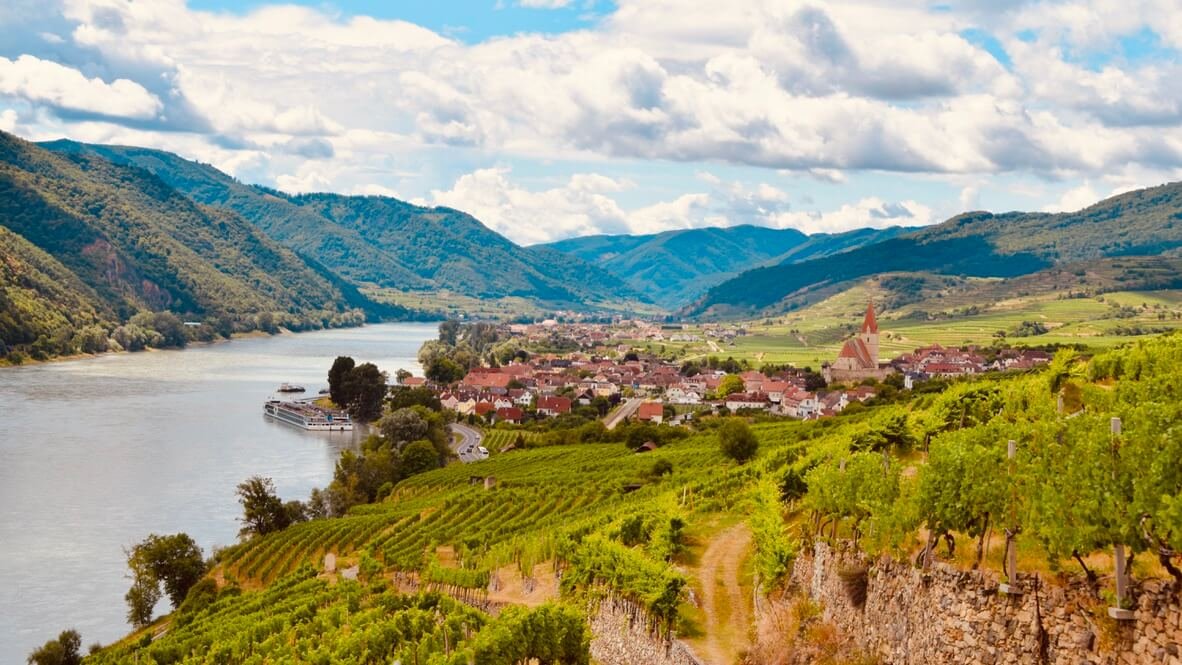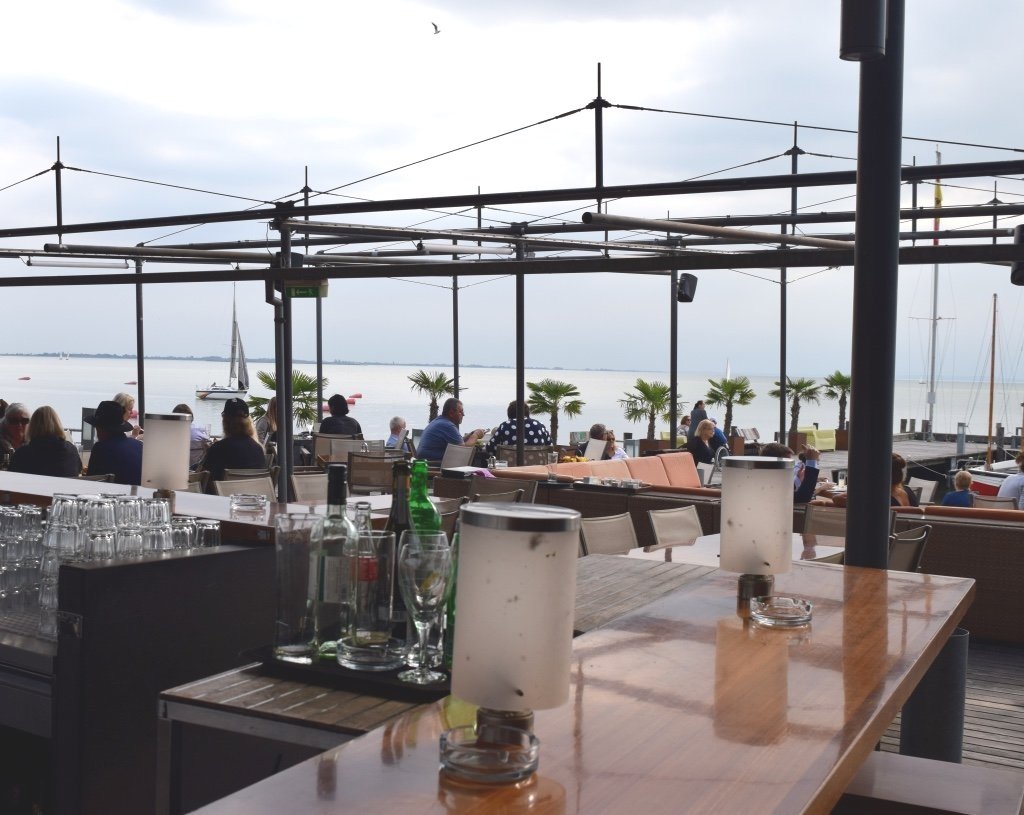VISIT AUSTRIA & THE AUSTRIAN WINE REGIONS

The beautiful River Danube and Weissenkirchen in the Wachau wine region
Photo source: Winekeller
Select an Austrian wine region for your next wine tour inspiration!
Which Austrian wine regions to explore:
Austria may be most famous for the ‘Sound of Music’, Mozart, mountains and Viennese pastries – but did you know that it’s also one of the most exciting wine producing countries in the world? Austria is home to a host of young, highly skilled winemakers who are producing some superb-quality, authentic, artisanal wines.
Geographically located in central Europe, but at the same latitude as France’s Burgundy region, Austria enjoys a strong continental climate, with warm, sunny summer and autumn days and northerly, cool nights, key to the development of fresh, aromatic wines with good body and fine character, for which Austria has become famous in recent years.
Austria wine map
The 4 main Austrian wine regions
Most Austrian wine is made in the eastern part of the country, due to the more favourable climate conditions.
There are 3 main wine regions, namely: Niederösterreich (or Lower Austria), the largest Austrian wine region; Burgenland, known for its red and sweet wines and Steiermark; the home of incredibly elegant wines.
In addition there is Wien (capital city, Vienna), representing some 600 hectares of vineyards surrounding the city.
Wine tourism in Austria
For over two millennia, wine has been a part of Austrian culture. However, despite being respectful to its ancient traditions, Austria has now become an exciting, modern wine producing country. Wine tourists are of course drawn to Austria for the superb quality wine, but also to visit the impressively modern wineries and to enjoy the warm hospitality and traditions of its people, their great respect for Nature and the environment and the relaxed way of life and beautiful scenery.
Austrian wines - Austrian wineries
Austrian wine is highly valued and increasingly recognised worldwide by wine lovers, and especially sommeliers, for the superbly pure, white wines and their food matching qualities, ranging from bone dry and characterful, to lusciously sweet. Their red wines are also now gaining recognition, but it’s the white wines which dominate.
Austrian wine is firmly rooted in Austria’s wonderful culinary tradition. However, the typical freshness and body of the wines make them an excellent match for an exceptionally wide range of cooking styles and cuisines: from Central Europe to the Mediterranean and beyond to Asian foods and from ethnic food to fusion.
Environmental protection and biodiversity are a priority in Austria, where around 23% of the agricultural area and 15% of all vineyards are already managed according to organic farming guidelines. (Source: Ministry for Agriculture, Regions and Tourism, July 2020).
Austrian wines are popular for their food matching qualities
Value for money
Family farms dominate Austrian winemaking and the focus is more on artisan production, not mass production. As a result, you won’t find a good Austrian wine for sale outside of Austria at an ‘entry-level price’. However, Austrian wines are recognised as being excellent ‘value for money’, because of their exceptional quality.
Austrian wine grapes
What are the leading grape varieties of Austria?
Although international grape varieties are prominent and grow well across Austria, it’s the indigenous Austrian grape varieties which are centre stage and which are producing the most exciting Austrian wines.
Chief of these is Grüner Veltliner, which has established itself as one of the world’s greatest white wines.
Austrian white wines:
Two-thirds of Austrian wines are white and the Austrian Grüner Veltliner grape variety dominates. It accounts for about 30% of Austria’s vineyards.
Grüner Veltliner has a fresh, aromatic and often quite peppery taste and pairs wonderfully with fish, asparagus and white meats, as well as Asian and slightly spicy dishes.
Riesling and Welschriesling are also important white grape varieties.
Austrian red wines:
Three local grape varieties dominate Austria’s red wines - Zweigelt, incredibly juicy and fruity; Blaufränkisch, with its deep berry and cherry flavours and Sankt Laurent, part of the Pinot family, expressing lovely morello cherry notes.
Grüner Veltliner - Austria’s top white grape
Zweigelt - indigenous Austrian red grape
Austrian wine types
Austria probably has some of the world’s strictest wine regulations, which have seen notable changes in recent years, surrounding what are called the DACs (Districtus Austriae Controllatus). Similar to the French DOC structure, strict rules apply for each of the 15 or so DACs, in order to ensure only the truest expression of wines are produced from each area. Wines which don’t meet these conditions have to use the regional appellation - ie Niederösterreich, Burgenland, Steiermark or Wien.
Each DAC has its own strictly defined wine classifications, so these are discussed in the appropriate regional web pages and include:
Niederösterreich: Niederösterreich region, Carnuntum DAC, Kamptal DAC, Kremstal DAC, Thermenregion, Traisental DAC, Wachau DAC, Wagram, Weinviertel DAC
Burgenland: Burgenland region, Eisenberg DAC, Leithaberg DAC, Mittelburgenland DAC, Neusiedlersee DAC, Rosalia DAC, Ruster Ausbruch DAC
Steiermark: Steiermark region, Südsteiermark DAC, Vulkanland Steiermark DAC, Weststeiermark DAC
Wien: Wien region, Wiener Gemischter Satz DAC
Austrian sparkling wine
Austria is also a producer of high quality sparkling wine, called Sekt (as in Germany). There are 3 levels of Sekt: Klassik, Reserve and Grand Reserve, the second two being made by the traditional Champagne method.
Visiting Stift Göttweig, near Krems
Cycling along the Danube in the Wachau
Enjoying the local 'Heurigenlokal' in Dürnstein
Relaxing at Lake Neusiedl, Burgenland
Your trip to Austria - planning a wine tour of Austria’s wine regions
If you like the idea of exploring all that Austrian wine country has to offer, you can travel the “Weinstraße” (wine street), an 830 km long route, which leads through eight different wine regions and more than 150 wine villages!
If that is a bit too much for you, then perhaps explore a main wine region and discover the variety of wines, villages, monuments, scenery and landscapes - for example tour some of the different DAC wine areas within the region of Lower Austria - Niederösterreich.
A good idea is to contact the appropriate tourist offices of key towns/regions and search for advice on touring the wine region, either by yourself or as part of a guided tour with transport included.
A great way to discover new wines, soak up the culture and sample some fabulous, traditional Austrian food is to visit a Heurigenlokal - a wine tavern where local winemakers open their doors to serve their new wine during alternate months of the growing season. Simple, local dishes, salads and meat and cheese platters are also served, often along with some local music (schrammelmusik)!
Hiking trails in Austria
Austria is a hiker’s paradise and there are many great hiking trails for experienced and new hikers alike. Combine some hiking with wine tasting to enjoy Austria’s natural beauty and beautiful landscapes. See here for a guide on hiking in Austria.
See our different Austrian wine region website pages and read our suggested wine tour blogs for inspiration, information and advice about which regions to visit, which vineyards to visit and what to see and do in the area!
For more information about visiting Austria see here . Also see Austrian Wines.
Austrian wine language
Weisswein - White wine
Rotwein - Red wine
Rose - Rosé
Spätburgunder - Pinot noir
Weissburgunder - Pinot blanc
Grauburgunder - Pinot gris/grigio
Heurigenlokal - wine tavern
Trocken - Dry
Halb-trocken - Medium-dry
Feinherb - Medium-dry (but slightly sweeter than Halb-trocken)
Weingut - Winery/wine estate
Weingarten - Vineyard
Ried - a single-cru, named vineyard




